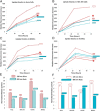Engineering nanoparticles to overcome barriers to immunotherapy
- PMID: 29313006
- PMCID: PMC5689503
- DOI: 10.1002/btm2.10005
Engineering nanoparticles to overcome barriers to immunotherapy
Abstract
Advances in immunotherapy have led to the development of a variety of promising therapeutics, including small molecules, proteins and peptides, monoclonal antibodies, and cellular therapies. Despite this wealth of new therapeutics, the efficacy of immunotherapy has been limited by challenges in targeted delivery and controlled release, that is, spatial and temporal control on delivery. Particulate carriers, especially nanoparticles have been widely studied in drug delivery and vaccine research and are being increasingly investigated as vehicles to deliver immunotherapies. Nanoparticle-mediated drug delivery could provide several benefits, including control of biodistribution and transport kinetics, the potential for site-specific targeting, immunogenicity, tracking capability using medical imaging, and multitherapeutic loading. There are also a unique set of challenges, which include nonspecific uptake by phagocytic cells, off-target biodistribution, permeation through tissue (transport limitation), nonspecific immune-activation, and poor control over intracellular localization. This review highlights the importance of understanding the relationship between a nanoparticle's size, shape, charge, ligand density and elasticity to its vascular transport, biodistribution, cellular internalization, and immunogenicity. For the design of an effective immunotherapy, we highlight the importance of selecting a nanoparticle's physical characteristics (e.g., size, shape, elasticity) and its surface functionalization (e.g., chemical or polymer modifications, targeting or tissue-penetrating peptides) with consideration of its reactivity to the targeted microenvironment (e.g., targeted cell types, use of stimuli-sensitive biomaterials, immunogenicity). Applications of this rational nanoparticle design process in vaccine development and cancer immunotherapy are discussed.
Keywords: cancer immunotherapy; drug delivery; intracellular delivery; targeted nanoparticles; tissue permeation; vaccines.
Figures






Similar articles
-
Nanoparticle-Based Nanomedicines to Promote Cancer Immunotherapy: Recent Advances and Future Directions.Small. 2019 Aug;15(32):e1900262. doi: 10.1002/smll.201900262. Epub 2019 Mar 25. Small. 2019. PMID: 30908864 Review.
-
Advances in Engineered Polymer Nanoparticle Tracking Platforms towards Cancer Immunotherapy-Current Status and Future Perspectives.Vaccines (Basel). 2021 Aug 23;9(8):935. doi: 10.3390/vaccines9080935. Vaccines (Basel). 2021. PMID: 34452059 Free PMC article. Review.
-
Current issues of RNAi therapeutics delivery and development.J Control Release. 2014 Dec 10;195:49-54. doi: 10.1016/j.jconrel.2014.07.056. Epub 2014 Aug 9. J Control Release. 2014. PMID: 25111131 Review.
-
Nanoparticle Drug Delivery Systems Designed to Improve Cancer Vaccines and Immunotherapy.Vaccines (Basel). 2015 Aug 27;3(3):662-85. doi: 10.3390/vaccines3030662. Vaccines (Basel). 2015. PMID: 26350600 Free PMC article. Review.
-
Advanced targeted therapies in cancer: Drug nanocarriers, the future of chemotherapy.Eur J Pharm Biopharm. 2015 Jun;93:52-79. doi: 10.1016/j.ejpb.2015.03.018. Epub 2015 Mar 23. Eur J Pharm Biopharm. 2015. PMID: 25813885 Review.
Cited by
-
Introduction to special issue on "Nanoparticles in Medicine: Targeting, Optimization and Clinical Applications".Bioeng Transl Med. 2016 Jun 30;1(1):8-9. doi: 10.1002/btm2.10012. eCollection 2016 Mar. Bioeng Transl Med. 2016. PMID: 29313003 Free PMC article. No abstract available.
-
Challenges and Perspectives of Standard Therapy and Drug Development in High-Grade Gliomas.Molecules. 2021 Feb 22;26(4):1169. doi: 10.3390/molecules26041169. Molecules. 2021. PMID: 33671796 Free PMC article. Review.
-
The Role of Nanomaterials in the Treatment of Diseases and Their Effects on the Immune System.Open Access Maced J Med Sci. 2019 Jun 14;7(11):1884-1890. doi: 10.3889/oamjms.2019.486. eCollection 2019 Jun 15. Open Access Maced J Med Sci. 2019. PMID: 31316678 Free PMC article. Review.
-
Current Immunotherapy Strategies for Rheumatoid Arthritis: The Immunoengineering and Delivery Systems.Research (Wash D C). 2023 Oct 17;6:0220. doi: 10.34133/research.0220. eCollection 2023. Research (Wash D C). 2023. PMID: 39902178 Free PMC article. Review.
-
Ganglioside-Functionalized Nanoparticles for Chimeric Antigen Receptor T-Cell Activation at the Immunological Synapse.ACS Nano. 2022 Nov 22;16(11):18408-18420. doi: 10.1021/acsnano.2c06516. Epub 2022 Oct 25. ACS Nano. 2022. PMID: 36282488 Free PMC article.
References
-
- Adams JL, Smothers J, Srinivasan R, Hoos A. Big opportunities for small molecules in immuno‐oncology. Nat Rev Drug Discov. 2015;14(9):603–622. - PubMed
-
- Mahoney KM, Rennert PD, Freeman GJ. Combination cancer immunotherapy and new immunomodulatory targets. Nat Rev Drug Discov. 2015;14(8):561–584. - PubMed
Publication types
LinkOut - more resources
Full Text Sources
Other Literature Sources

